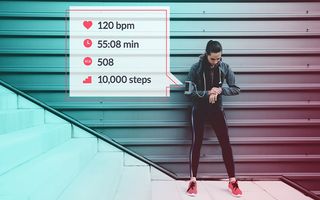
No matter what motivation you need to get moving, there’s a tool for that. Aurora University Online’s Modern Fitness Technology Guide lays out the many and various ways that technology – from wearable tech to streaming fitness classes – can help consumers and athletes get excited to exercise. In this guide, we’ll highlight findings from the University’s online M.S. in Exercise Science study on modern fitness technology tools. Whether you’re just starting out, seeking the next hottest workout, or looking to get more competitive with your training, here are the many technology options for limbering up, stretching out, and raising your heart rate.
Best for: People Who Think Exercise is Boring
A common excuse for not working out is that exercise is boring. Staring at the bottom of the pool while doing laps or the screen of a stationary bike can get old, fast. Luckily, there are other options – specifically, a category of working out called “exergaming.”
Exergaming, or the combination of exercise and high-tech gaming, became popular with the advent of Nintendo’s Wii console and the arcade game Dance Dance Revolution. For those who find exercise boring, playing these games will give them a workout without even realizing it. Research from Harvard found that “the Wii Aerobics package, for example, gives you a workout that’s the equivalent of walking at 3 miles per hour.” That kind of moderate-intensity activity won’t turn players into pro-athletes, but it does provide tons of health benefits without the tedium of some workouts.
The next iteration of exergames includes virtual reality (VR) technology. VR promises to up the workout intensity while providing an immersive, entertaining experience. Games like Knockout League and Thrill of the Fight have been proven by the Virtual Reality Institute of Health and Exercise to burn approximately 8-10 calories per minute, the equivalent of rowing. And, as VR is still relatively new, expect to see more types of this exercise tech come to the market in the next few years

Best for: Fitness Fanatics
For those who want to get a solid workout in frequently, on-demand, in-home fitness technology is usually the best option. Peloton has cornered the in-home market with its stylish bike, treadmill, and schedule of live classes available digitally, achieving almost cult-like status since its first product launched in 2012. The company is worth more than $4 billion as of February 2019 and has a reputation for being the “Apple of fitness.” According to AU Online's guide, “The major draw is that the device provides home users with 24-hour access to live and on-demand group workout classes . . . Additionally, in the spirit of virtually any piece of modern fitness technology, home users receive live, in-class data metrics that span cadence, resistance, output, and heart rate.”
Best for: Early Adopters Looking For The Next Fitness Trend
Peloton has many competitors, but one piece of in-home fitness technology is causing a buzz: Mirror. Mirror looks like its namesake, a mirror, until you turn it on. It’s actually an LCD screen that streams fitness classes right into your home. Users open the Mirror app, add key health details such as their height, weight, and fitness goals, as well as any injury details. Then, users connect with the Mirror screen using a Bluetooth heart rate monitor (or Apple Watch) that tracks heart rate and calories burned. Sign up for any of Mirror’s 50-plus on-demand classes: barre, yoga, boxing, strength training, HIIT, and more, all at different levels. When not in use, the Mirror goes back to being . . . a mirror.
Best for: Professional Athletes
In-home technology is great for those who aren’t getting paid to compete at the top of their game. But, professional athletes require more advanced fitness technology that can provide data points to improve and optimize performance. Catapult Sports produces fitness technology used by the NBA to reduce injuries and collect data on how players move, including their accelerations, elevations, and jumping ranges. This is the next level of fitness technology, a tool that allows coaches to “tailor programs specifically to each player’s unique physiology, correcting injury-inducing problems like imbalances between each side of the body,” according to Fast Company. “A player, for example, could be favoring one leg over the other when jumping, due perhaps to an old injury that never properly healed or muscular weakness never addressed.”

Best for: Amateurs Looking To Raise Their Game
Perhaps the best multi-use fitness tech tool is the Apple Watch, used by pros and amateurs alike to improve training. Apple Watch is one of the best smartwatches on the market, getting high ratings in our TechRadar guide.
Why is it great for athletes and fitness aficionados? Apple Watch can differentiate between regular movement and actual exercise. There are reminders to stand up and move around during the day. And, even more importantly, users can see how much they’ve moved, exercised, and stood throughout the day right on the easily read interface. GPS capability can show how far the wearer has run or cycled, and the sleep tracker monitors the user’s recovery between sessions. Like the Fitbit line, Apple Watch is one of the many great fitness tracking tools on the market today.
Modern fitness technology continues to evolve as capabilities become more advanced and consumers demand more data for their workouts. For more on the future of fitness wearables, read AU Online's guide here.

Get daily insight, inspiration and deals in your inbox
Get the hottest deals available in your inbox plus news, reviews, opinion, analysis and more from the TechRadar team.
